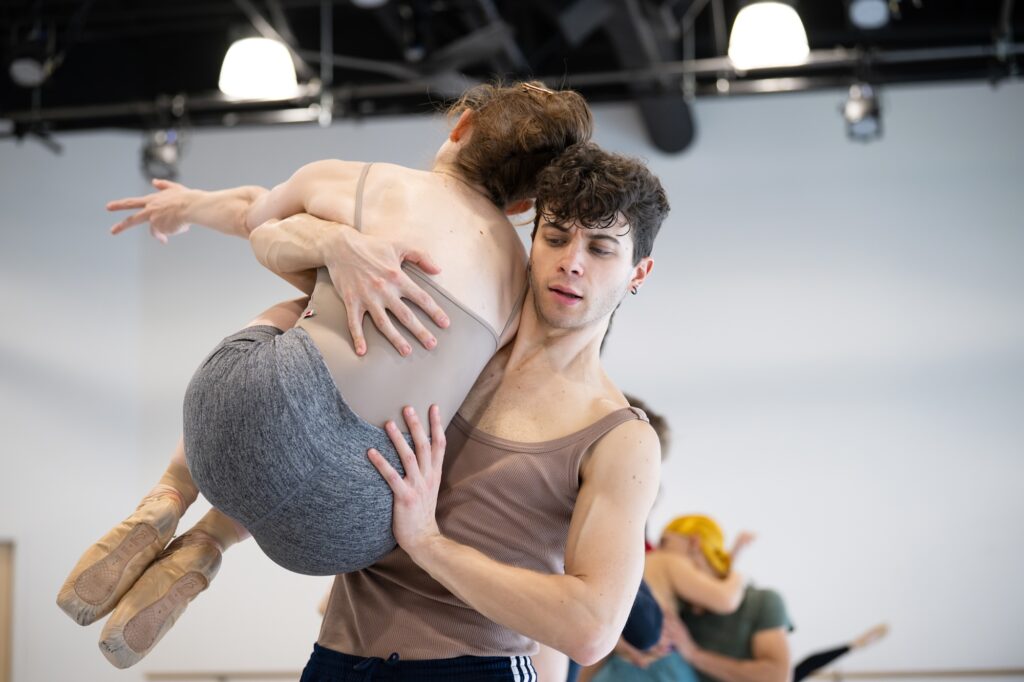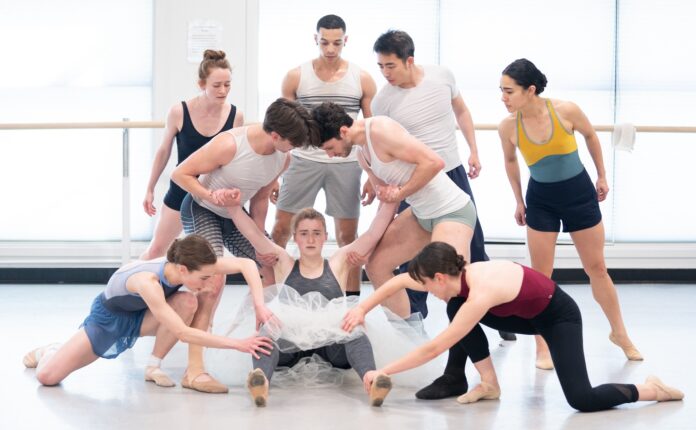Smuin Ballet’s spring season (Fri/25-May 4, YBCA, SF) promises a program that spans decades, from founder Michael Smuin’s “Eternal Idol,” created in 1969 before his eponymous SF company even existed, through “I Remember Now,” Amy Seiwert’s first ballet as the new artistic director of the troupe. In between are Trey McIntyre’s “Wild Sweet Love” and “Sinfonietta” by former company member and choreographer Rex Wheeler (audiences also know Wheeler by his famed drag alter ego Lady Camden). It’s not just your imagination that love is the predominant theme; however, it’s what lies beneath the surface that is more far more intriguing.
Inspired by August Rodin’s sculptures, perhaps both The Kiss and Eternal Idol, Smuin created this work for American Ballet Theatre stars Cynthia Gregory and Ivan Nagy, awakening the bronze couple to dance to Chopin’s romantic Piano Concerto no. 2 in F minor. It has been performed by a number of other companies over the years, with Smuin Ballet’s last showing in 2018 for the company’s 25th anniversary. (As a young ballet student in New York, I had the privilege of seeing it on stage when it debuted.)
As with any piece of art, inanimate or animate, interpretation is always left to the observer. While the ballet The Eternal Idol could easily be deemed intensely romantic, some writers from the past had different ideas about the statue’s meaning. It was also known as Sacrificial Victim. The writer Jules Renard said about it, “A man, vanquished, his arms behind his back, kisses a woman under the breasts, his lips against her skin, and the woman seems overcome with sadness. I cannot easily detach myself from that.” Famed poet Rainer Maria Rilke wrote, ”One doesn’t dare assign a meaning to it… A heaven is near, but is not yet attained; a hell is near, and not yet forgotten.”

Seiwert’s I Remember Now emerged from her own struggle to recover from a surgery. “My feeling in that moment was that the greatest gift that we can give one another in the world is to alleviate someone else’s pain,” she emphasized. “So I want people to remember this feeling of hope and joy and momentum and vibrancy.” She felt music by contemporary composer Oliver Davis would work well, but then she realized that “Rex’s piece actually does that really beautifully [expresses the same feelings as Davis’s music], and my job is to create what we don’t have.
“I found an album called The Light and Dark that’s inspired by someone’s near death experience.” Of the different composers on it, Seiwert chose pieces by Johann Johannsson, Kristin Agee, Benji Merrison, Dario Comuzzi, and Dario Forzatand that “gave the sense of being between those two worlds that I was longing for.
“The piece really evolved into being about vulnerability because I think for all of us who make work there’s always a little bit of the autobiographical. It became about how we mask that and how we can connect when we let go of the armor. I think I like how it evolved, and it’s not in the way I thought it would. But isn’t that what art’s about actually in the end?”
“Sinfonietta” by Wheeler started out as part of the Choreography Showcase. He was asked by Artistic Director Emerita Celia Fushille to expand it so it could become part of the regular Smuin repertoire in 2017. His inspiration was his grandmother who was an accomplished watercolor artist, and hopes that his choreography has caught glimpses of her art. Set to music by Boris Tchaikovsky, not that other Tchaikovsky, you still hear echoes of the Russian style reminiscent of composers like Prokofiev and Shostakovich.
Recently Wheeler’s life changed dramatically. “In my meeting when I talked to Amy [Seiwert] and Celia [Fushille] [about leaving the company], it was just really difficult and uncomfortable at first,” relates Wheeler. “I told them that I love this company so much, but my heart wants to go and try other things. I love dancing, but I’ve always loved choreographing a little tiny bit more. And if I go and become a drag queen, I’ll be a richer artist.
Help us save local journalism!
Every tax-deductible donation helps us grow to cover the issues that mean the most to our community. Become a 48 Hills Hero and support the only daily progressive news source in the Bay Area.
“It was a big risk to leave a ballet company and cut a dancing career short. But they were really supportive and when I asked if I can i still come and choreograph for you, they said, of course.
“I now definitely have a lot of life experience in performing in other ways. I’ve produced a one person show, as my alter ego Lady Camden, here in SF and both a Christmas show and a Pride show. I have experience with writing and constructing works in ways that are not just about steps, but about storytelling that involves comedy and timing. I’ve learned how to shape an evening. So it might be fun to see how that all gets infused into a ballet.”
McIntyre’s “Wild Sweet Love,” a ballet for nine dancers, was choreographed in 2007 for Sacramento Ballet, and has been mounted on many other companies over the past 18 years. McIntyre is proud that the latest remounting was for the State Ballet of Georgia in Tbilisi, by the renowned artistic director Nina Ananiashvili. The work has an unusual musical accompaniment—Lou Reed, Roberta Flack, Jose Alfredo Jimenez, The Partridge Family, Felix Mendelssohn, and The Zombies–yet it all seems to work.
McIntyre admits, “People keep asking me about the music because it’s so eclectic. I’m trying to come up with the honest answer, but I really think it was my playlist that I had in the car on my way to rehearsal. It struck me that all these songs deal with romantic love. I was really thinking about all I had picked up from music in terms of my idealism about relationships and the way these songs instruct us to project this perfect person to solve everything. Grappling with it and wanting to just think about it choreographically, I shaped it into a wedding party DJ playlist. I wanted to have this central figure who was like me, the observer, the person who could grow from the experience and come to a sense of self by the end of it.”
“When my company was in Boise, a woman in the audience began singing “Amazing Grace” during one of the shows. There was a duet between two men, so I think she was unnerved by that. I don’t know what happened with her, but hopefully she develops some compassion. It was interesting to watch because it’s a very [heteronormatively] coupled piece except for the single woman. We’ve moved on from that in dance over these years, and now it is so much more acceptable [to do something different]. Now no one blinks an eye. It seems like a throwback to how it used to be, very much an example of the heteronormative practice of coupling in our culture.”
SMUIN BALLET Fri/25-May 4, YBCA, SF. More info here.





